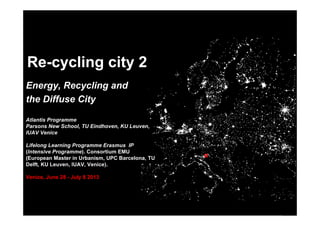Riciclare cittaĖ 2
- 1. Atlantis Programme Parsons New School, TU Eindhoven, KU Leuven, IUAV Venice Lifelong Learning Programme Erasmus IP (Intensive Programme). Consortium EMU (European Master in Urbanism, UPC Barcelona, TU Delft, KU Leuven, IUAV, Venice). Venice, June 28 - July 8 2013 Re-cycling city 2 Energy, Recycling and the Diffuse City
- 2. Re-cycle1: the city as renewable resource LIFE-CYCLES, EMBODIED ENERGY, INCLUSION http://issuu.com/extremecities/docs/recycling_city?mode=window&printButtonEnabled=false&backgroundColor=%23222222
- 3. Re-cycle 2: the city as Gross Fixed Energy Capital ENERGY, RECYCLING AND THE DIFFUSE CITY
- 5. Embodied energy The total energy consumption over a building's lifetime is the sum of grey, or hidden, or embodied energy and the energy required over the course of its life cycle to cover the needs of heating, hot water, electricity... Embodied energy is the energy âtrappedâ in the body of the territory. Embodied energy is a cost. The more energy is embodied in an object, the more entropy required its production. Recycling is considering priority when managing this gross fixed energy capita which territory is. It focuses on the physical stratification of what exists.
- 6. immigrants intensity immigrant population / urban square meters
- 7. Re-cycle and Exclusion If we accept that the city is a renewable resource, that it is subject to life-cyles, we can observe it as embodied energy, thus trying to understand it in terms of entropy and ways to adapt to it; focusing on how energy is used we observe new social geographies. The way territories make use of their energy and re-cycle in new lifecycles, implies choosing priorities, what to recycle, when, and who will take it; which creates new exclusions.
- 8. Questions and _fields 1.the crisis of small and medium enterprises on which the diffuse city has been built According to some estimates, in the province of Treviso alone at least 20% of industrial warehouses are disused or underused. If this were true this means that 18 million sqm of built surface is available only in the province of Treviso Greyfields 1: recycling industrial boxes
- 9. Questions and _fields 2. aging population and migrants Like many other parts of Italy, in the Veneto region the aging of the population is remarkable and it will produce, in the near future, a demand for new habitat and services. Considering the actual and future presence of migrants, with their habits and lifestyles, it seems reasonable to think that a relevant part of the housing stock will be subjected to a through revision. Greyfields 2: recycling habitat
- 10. Questions and _fields 3. the diffuse city after peak oil. A territory in transition The scenario "no auto" defines a high inten-city (very well served by public transport) and a low inten-city. The railways is the main support of a new mobility system, which will reduce or eliminate private cars. In this hypothesis, a project of recycling should start from the spaces close to the train stations. Moreover, the drastic reduction of cars will free a lot of space, which can be redesigned for new uses and functions. Greyfields 3: recycling infrastructures
- 11. in between high inten-city and low inten-city Camposampiero Mestre/Marghera Ospedale al Mare - Lido
- 12. in between high inten-city and low inten-city Camposampiero
- 14. in between high inten-city and low inten-city Mestre /Marghera
- 18. New Actors and the New Walfare Agenda Ospedale al Mare - Lido


















